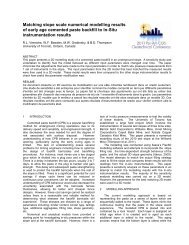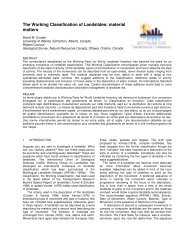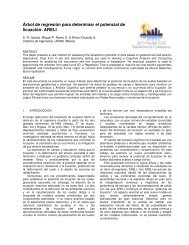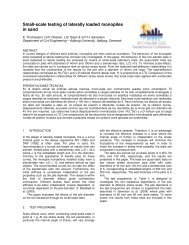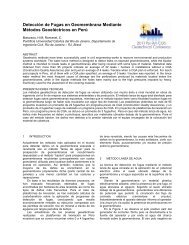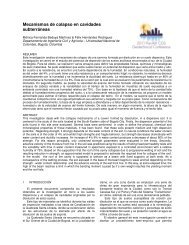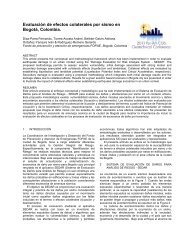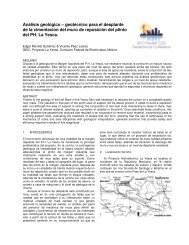author's guideline for preparation of manuscripts for eurosteel 2005 ...
author's guideline for preparation of manuscripts for eurosteel 2005 ...
author's guideline for preparation of manuscripts for eurosteel 2005 ...
You also want an ePaper? Increase the reach of your titles
YUMPU automatically turns print PDFs into web optimized ePapers that Google loves.
Tunnel System Per<strong>for</strong>mance Based on Different<br />
Case Histories<br />
S.A.Mazek<br />
Associate Pr<strong>of</strong>essor, Civil Engineering Department, Military Technical<br />
College, Cairo, Egypt.<br />
S. M. Atrash<br />
Ph.D., Civil Engineering Department, Military Technical College, Cairo,<br />
Egypt.<br />
ABSTRACT<br />
Development <strong>of</strong> tunneling is an effective tool to overcome high-density population challenges such as transportation and<br />
utilities activities. Tunnels are used <strong>for</strong> several purposes such as construction <strong>of</strong> sewers, railway, and roadway tunnels.<br />
The Greater Cairo Metro tunnel, El-Azhar road tunnels, and the sewage tunnel in the Greater Cairo city are considered<br />
as major projects to solve transportation and environmental problems. There are technologies to assist in excavation<br />
such as tunnel boring machine (TBM) and cut and cover method. To better understand the per<strong>for</strong>mance <strong>of</strong> the tunnel<br />
system, it is necessary to investigate the geotechnical problems related to tunneling.<br />
In the present study, the finite element model (FEM) is proposed to predict per<strong>for</strong>mance <strong>of</strong> tunnel system under shadow<br />
<strong>of</strong> three case histories. The three case studies presented and discussed in this study give good and rare opportunity to<br />
understand the per<strong>for</strong>mance <strong>of</strong> the tunnel system. The constitutive model <strong>for</strong> this analysis utilizes elasto-plastic<br />
materials. A yielding function <strong>of</strong> the Mohr-Coulomb type and a plastic potential function <strong>of</strong> the Drucker-Prager type are<br />
employed. A linear constitutive model is employed to represent the tunnel liner.<br />
The response <strong>of</strong> the tunnel system is described by the ground movement caused by tunneling. The ground movement is<br />
presented and calculated using the proposed 3-D FEM. The recorded measurements are also presented <strong>for</strong> the three<br />
case histories. The results obtained by the 3-D numerical model are compared with those obtained by the field<br />
measurement to assess the accuracy <strong>of</strong> the proposed 3-D numerical model. There is a good agreement between the<br />
results obtained by the 3-D FEM and those obtained by the field recording.<br />
RÉSUMÉ<br />
Développement de tunnel est un outil efficace pour relever les défis <strong>for</strong>te densité de population telles que les activités de<br />
transport et les services publics. Les tunnels sont utilisés à plusieurs fins, comme la construction des égouts, des<br />
chemins de fer, tunnels et routes. Le Grand Caire Metro tunnel, tunnels routiers El-Azhar, et le tunnel des eaux usées<br />
dans la ville du Grand Caire sont considérés comme de grands projets pour résoudre les problèmes de transport et<br />
l'environnement. Il existe des technologies pour aider à l'excavation comme tunnelier (TBM) et la méthode en tranchée<br />
couverte. Pour mieux comprendre la per<strong>for</strong>mance du système de tunnel, il est nécessaire d'enquêter sur les problèmes<br />
géotechniques liés à effet tunnel.<br />
Dans la présente étude, le modèle éléments finis (FEM) est proposé pour prédire la per<strong>for</strong>mance du système de tunnel<br />
sous l'ombre des trois histoires de cas. Les trois études de cas présentés et discutés dans cette étude donne l'occasion<br />
bonne et rare pour comprendre la per<strong>for</strong>mance du système de tunnels. Le modèle constitutif pour cette analyse utilise<br />
des matériaux élasto-plastique. Une fonction de rendement de type Mohr-Coulomb et une fonction potentiel plastique du<br />
type Drucker-Prager sont employés. Un modèle linéaire est constitutive employés pour représenter le revêtement de<br />
tunnel. La réponse du système de tunnels est décrite par le mouvement du sol causé par effet tunnel. Le mouvement de<br />
terrain est présenté et calculé en utilisant la proposition 3-D FEM. Les mesures enregistrées sont également présentés<br />
pour les trois histoires de cas. Les résultats obtenus par le modèle 3-D numériques sont comparés avec ceux obtenus<br />
par la mesure sur le terrain pour évaluer la précision du modèle numérique proposé en 3-D. Il ya un bon accord entre les<br />
résultats obtenus par le FEM 3-D et ceux obtenus par l'enregistrement sur le terrain.<br />
KEYWORDS: tunnels, numerical modelling and analysis, finite element analysis, de<strong>for</strong>mations.<br />
1. INTRODUCTION<br />
Tunneling leads to ground movement due to the<br />
associated stress change around an advancing tunnel.<br />
The numerical techniques are widely used to predict the<br />
ground movements (Berant and cambou, 1998). Finite<br />
element method is considered the most appropriate<br />
analytical technique to solve geotechnical problems<br />
(Addenbrooke and Potts, 2001; El- Nahhas, 1986; El-<br />
Nahhas et al., 1990; Karakus and Fowell, <strong>2005</strong>; Karakus,<br />
2007; Mazek, 2004; Mazek et al., 2006; Oettl and<br />
H<strong>of</strong>stetter, 1998). Modeling <strong>of</strong> geotechnical properties<br />
and tunneling process is the sophisticated problem (El-<br />
Nahhas, 1986; Mazek et al., 2004). In this study, the<br />
Greater Cairo Metro tunnel, El- Azhar road tunnels, and<br />
the Greater Cairo Wastewater tunnel in central Cairo city<br />
are considered as three case studies. The tunnel system<br />
per<strong>for</strong>mance is studied. The tunnel system model is<br />
proposed by 3-D nonlinear finite element analysis (FEA)<br />
under the shadow <strong>of</strong> the three case histories. The aim <strong>of</strong>
this study is to understand per<strong>for</strong>mance <strong>of</strong> the tunnel<br />
systems. In the 3-D nonlinear finite element modeling,<br />
tunneling process and interaction effects between tunnel<br />
and soil around tunnel are investigated. The 3-D nonlinear<br />
finite element analysis is used to estimate vertical<br />
displacements at ground surface due to tunneling.<br />
In this Study, the Greater Cairo Metro tunnel, El Azhar<br />
road tunnels, and the Greater Cairo wastewater tunnel are<br />
discussed through a comparison between the results<br />
calculated by the 3-D nonlinear finite element analysis<br />
and the results recorded by field measurements to assess<br />
the accuracy <strong>of</strong> the proposed 3-D finite element analysis<br />
(FEA). The typical geotechnical and soil properties used<br />
in this study are presented in Table 1. However, the<br />
results calculated by the finite element analysis agree well<br />
with those obtained by the field measurements.<br />
2. FINITE ELEMENT MODEL<br />
The finite element computer program (COSMOS/M, 2003)<br />
is used in this study. The finite element model takes into<br />
account effects <strong>of</strong> vertical overburden pressure, lateral<br />
earth pressure, and ground water table. The soil media,<br />
the tunnel lining, and the interface surface are simulated<br />
using appropriate finite elements. The numerical<br />
modeling <strong>of</strong> the soil tunnel system must reflect the<br />
characteristic <strong>of</strong> the ground continuum and the tunnel. In<br />
addition, the interface between the soil and the tunnel<br />
system should be idealized in the numerical model. Solid<br />
elements are used <strong>for</strong> modeling the soil media and the<br />
thick shell elements <strong>for</strong> modeling the tunnel liner. The<br />
thick shell element models both membrane (in plane) and<br />
bending (out plane) behavior <strong>of</strong> the tunnel structure. The<br />
solid element is chosen since it posses in-plane and out<strong>of</strong>-plane<br />
stiffness. The solid element allows <strong>for</strong> both inplane<br />
and out-<strong>of</strong>-plane loads. The solid element is<br />
prismatic in shape. The prismatic solid element and the<br />
triangular shell element interface are used between the<br />
soil media and the tunnel liner to ensure the compatibility<br />
conditions at the interface between them as well as the<br />
associated stress and strains along the interface surface.<br />
The vertical boundaries <strong>of</strong> the 3-D finite elements model<br />
are restrained by roller supports to prevent a movement<br />
normal to the boundaries. The horizontal plane at the<br />
bottom <strong>of</strong> the mesh represented a rigid bedrock layer and<br />
the movement at this plane is restrained in all three<br />
directions. The movement at the upper horizontal plane is<br />
free to simulate a free ground surface, as shown in Fig. 1.<br />
In the finite element analysis, the loading attributed to the<br />
construction process is considered.<br />
3. PROPERTIES OF TUNNEL LINING AND SOIL<br />
The three case studies discussed in this study were<br />
constructed at central Cairo city. The project area under<br />
analysis lies within the alluvial plain, which covers the<br />
major area <strong>of</strong> the low land portion <strong>of</strong> the Nile valley in<br />
Cairo vicinity (El-Nahhas, 1994; Mazek et al., 2001;<br />
Mazek et al., 2004; NAT, 1993, 1999, 2009). Site<br />
investigations along the project alignment have indicated<br />
that the soil pr<strong>of</strong>ile consists <strong>of</strong> a relatively thin surficial fill<br />
layer ranging from two to four metres in thickness. A<br />
natural deposit <strong>of</strong> stiff overconsolidated silty clay lies<br />
under the fill layer. This deposit includes occasional sand<br />
and silt partings <strong>of</strong> thickness from four to ten meters.<br />
Beneath the silty clay layers the sandy layer surrounding<br />
the entire excavation pr<strong>of</strong>ile extends down to the bedrock.<br />
The main soil parameters required to model the<br />
per<strong>for</strong>mance <strong>of</strong> different tunnel systems are presented in<br />
Table1. The constitutive relationship adopted in the<br />
analysis is an elasto-plastic model. The Mohr-Coulomb<br />
criterion is adopted. The friction angles ( ) adopted <strong>for</strong><br />
the layers have been obtained using laboratory test<br />
results from reconstituted samples. The vertical initial<br />
drained modulus (E v) is related to the effective pressure<br />
based on Janbu empirical equation as presented in Eq. 1<br />
(Janbu, 1963).<br />
3<br />
E<br />
v<br />
mpa<br />
( )<br />
p<br />
a<br />
n<br />
In which, the modulus number (m) and the exponent<br />
number (n) are both pure number and (P a) is the value <strong>of</strong><br />
the atmospheric pressure expressed in appropriate units.<br />
The nonlinear soil parameters used <strong>for</strong> elasto-plastic finite<br />
element analysis <strong>for</strong> different types <strong>of</strong> the soil are<br />
presented in Table 1 (NAT, 1993, 1999, 2009).<br />
The ground water table varies between two meters to four<br />
meters from the ground surface. Figure 2 shows the soil<br />
pr<strong>of</strong>ile along the Greater Cairo City. The ground surface<br />
displacement due to the construction <strong>of</strong> the tunnel is<br />
calculated in this study. The final diameter (D) <strong>for</strong> the<br />
metro tunnel is 9.06 m and the excavation diameter <strong>of</strong> the<br />
metro tunnel is 9.56 m. The final diameter (D) <strong>for</strong> the road<br />
tunnel is also 9.06 m and the excavation diameter <strong>of</strong> the<br />
metro tunnel is 9.56 m. The final diameter (D) <strong>for</strong> the<br />
sewage tunnel is 4.65 m and the excavation diameter <strong>of</strong><br />
the sewage tunnel is 5.15 m.<br />
The tunnel lining is assumed to behave in a linear manner<br />
in the 3-D nonlinear finite element analysis. The<br />
characteristic <strong>of</strong> the tunnel lining is tabulated in Table 2.<br />
4. GEOMETRIC BOUNDARIES OF 3-D MODEL<br />
4.1 Dimensions <strong>of</strong> Model<br />
The 3-D finite element mesh models a soil block with width,<br />
height, and depth in x, y, and z directions respectively, as<br />
shown in Fig. 1. The metro tunnel as the first case study is<br />
located at 18 meters from the ground surface, as shown in Fig.<br />
2. Drain analysis is adopted in the numerical model as the<br />
metro tunnel passes through the sand layer.<br />
The suitable geometric boundaries (model width and<br />
model height) are studied to reflect the per<strong>for</strong>mance <strong>of</strong> the<br />
metro tunnel system. The 3-D finite element analysis<br />
(FEA) is used to choose the suitable model width. The<br />
model width is varied from 40 meters to 120 meters.<br />
The calculated surface settlements due to tunnelling with<br />
different model widths are shown in Fig. 3. The calculated<br />
crown settlement <strong>of</strong> the metro tunnel with different model<br />
widths is also presented in Fig. 4. The calculated invert<br />
heave <strong>of</strong> the metro tunnel with different model widths are<br />
also presented in Fig 5. The results also show that the<br />
[1]
model width is 100 meters beyond which there is no<br />
change in soil stresses occurred due to tunnelling.<br />
Hence, the one-hundred-meter model width is chosen to<br />
reflect the per<strong>for</strong>mance <strong>of</strong> the metro tunnel system.<br />
The soil depth beneath the invert <strong>of</strong> the metro tunnel is<br />
2.5 times diameter <strong>of</strong> the tunnel (Mazek and Tehawy,<br />
2008). The one-hundred-meter model width and the fiftymeter<br />
model height are used in the FEA to compare the<br />
results obtained by both the 3-D FEA and the field<br />
measurement.<br />
For El-Azhar road tunnels (second case study), similar<br />
analysis is also carried out to choose the appropriate<br />
geometric boundaries. The results also show that when<br />
the model width exceeds 120 meters there is hardly any<br />
change in the soil stresses occurred due to tunnelling.<br />
The 120-meter model width and the fifty-meter model<br />
height are used in the FEA to compare the results<br />
obtained by both the 3-D FEA and the field measurement.<br />
For the sewage tunnel (third case study), similar analysis<br />
is again conducted to choose the appropriate geometric<br />
boundaries. The model width varies from 40 meters to<br />
100 meters. When the model width exceeds 80 meters<br />
there is no change in soil stresses occurred due to<br />
tunnelling. The eighty-meter model width is adopted in<br />
the 3-D FEA to compare the results obtained by both the<br />
FEA and the field measurement.<br />
4.2 Mesh Size<br />
The model mesh size is studied to reflect the per<strong>for</strong>mance<br />
<strong>of</strong> the metro tunnel system based on the FEA. The<br />
element size is varied from 2 m, 3 m, 4 m, up to 5 m along<br />
the outer boundary <strong>of</strong> the soil model block. The element<br />
size is also varied from 1 m, 1.5 m, 2 m, 2.5 m, up to 3 m<br />
along the metro tunnel liner. The calculated surface<br />
settlement based on different element sizes is presented<br />
in Table 3. The results reveal that as the element size<br />
along the outer boundary <strong>of</strong> the soil model block is smaller<br />
than three meters there is no change in calculated surface<br />
settlement due to tunneling. The results also show that as<br />
the element size along the metro tunnel liner is smaller<br />
than one meter there is no change in calculated surface<br />
settlement due to tunnelling.<br />
Similar analysis is also conducted <strong>for</strong> both El-Azhar road<br />
tunnels and the sewage tunnel to choose suitable element<br />
mesh size. A three-meter element size along the outer<br />
boundary <strong>of</strong> the soil model block and the one-meter<br />
element size along the tunnel liner are chosen <strong>for</strong> the rest<br />
<strong>of</strong> the 3-D FEA.<br />
4.3 Ground Loss<br />
The construction <strong>of</strong> a tunnel leads to a subsurface movement<br />
due to move soil towards excavated tunnel. The ground loss<br />
(V L) is the ratio <strong>of</strong> the difference between excavated soil<br />
volume and tunnel volume to the excavate soil volume. The<br />
ground loss ranged from 1.5 % to 4.5 % and reached to 6 % at<br />
some location along the Greater Cairo metro project (El-<br />
Nahhas, 1999). The impact <strong>of</strong> the ground loss on behavior <strong>of</strong><br />
the tunnel system is investigated to assess the accuracy <strong>of</strong> the<br />
3-D nonlinear FEA. Surface settlement due to construction <strong>of</strong><br />
the metro tunnel is calculated.<br />
In the parametric study, the ground loss is varied from 2%<br />
to 6% due to tunnelling. The calculated surface<br />
settlements against different ground losses due to the<br />
metro tunnel construction are analyzed and presented in<br />
Fig. 6. Based on the FEA, the ground loss <strong>of</strong> 4% is<br />
chosen to reflect the per<strong>for</strong>mance <strong>of</strong> the metro tunnel<br />
system. The results show that an increase <strong>of</strong> the ground<br />
loss due to tunneling leads to an increase <strong>of</strong> the surface<br />
settlements.<br />
For El-Azhar road tunnel, similar analysis is also carried<br />
out to choose the suitable ground loss. The ground loss<br />
<strong>of</strong> 3% is also chosen to reflect the per<strong>for</strong>mance <strong>of</strong> the<br />
road tunnels system.<br />
For the third case study (sewage tunnel), the ground loss<br />
<strong>of</strong> 6% is used in the 3-D FEA to reflect the per<strong>for</strong>mance <strong>of</strong><br />
the tunnel system.<br />
5. SOIL BEHAVIOR<br />
The stress changes in surrounding soils due to tunneling<br />
are investigated to study the detailed soil behavior around<br />
the tunnel systems. The stresses in the subsoil have<br />
undergone three phases <strong>of</strong> change. At these phases, the<br />
loading steps <strong>of</strong> the tunnel construction are simulated<br />
using the 3-D finite element analysis. First, the initial<br />
principal stresses are computed with the absence <strong>of</strong> the<br />
tunnel. Second, the excavation <strong>of</strong> the tunnel is modeled<br />
by means <strong>of</strong> the finite element method. The excavation is<br />
simulated by the removal <strong>of</strong> those elements inside the<br />
boundary <strong>of</strong> the metro tunnel surface to be exposed by<br />
the excavation. The excavated tunnel boundary is free to<br />
move until the soil comes into contact with the tunnel liner<br />
resulting from ground loss. The ground loss is considered<br />
in this study. The ground loss <strong>of</strong> 4 % is adopted in this<br />
study. Third, the calculated changes in stresses are then<br />
added to the initial principal stresses computed from the<br />
first phase to determine the final principal stresses<br />
resulting from the tunnel construction. The initial in-situ<br />
stresses <strong>of</strong> the excavated tunnel boundary be<strong>for</strong>e<br />
tunneling are calculated and plotted in Fig. 7. The final<br />
vertical stress change after tunneling is calculated and<br />
compared with the initial in-situ vertical stress be<strong>for</strong>e<br />
tunneling, as shown in Fig. 7. The results show that the<br />
soil above the crown <strong>of</strong> the metro tunnel settles downward<br />
and the soil under the invert <strong>of</strong> the metro tunnel<br />
excavation heaves based on the soil stress change due to<br />
tunneling process.<br />
6. 3-D FINITE ELEMENTS MODEL VERIFICATION<br />
(CASE HISTORIES)<br />
The per<strong>for</strong>mance <strong>of</strong> the three case studies is modeled<br />
using the 3-D nonlinear finite element elements analysis<br />
(FEA). In this study, the Greater Cairo Metro tunnel, El-<br />
Azhar road tunnel, and the Greater Cairo wastewater<br />
tunnel are studied through a comparison between the<br />
results calculated by the 3-D nonlinear model and the<br />
results recorded by field measurements.<br />
6.1 Greater Cairo Metro Tunnel Line 2 (First case history)
This case study is located along the Greater Cairo Metro<br />
Line 2, as shown in Figure 2. The nonlinear 3-D finite<br />
element model is used to predict the per<strong>for</strong>mance <strong>of</strong> the<br />
metro tunnel. The computed surface settlement is compared<br />
with those obtained by the field measurements so as to<br />
understand the behavior <strong>of</strong> the metro tunnel, as shown in<br />
Fig. 8. This comparison is used to assess the accuracy <strong>of</strong><br />
the proposed numerical model. The comparison shows that<br />
there is good agreement between the computed and the<br />
measured readings.<br />
6.2 El-Azhar Road Tunnels (Second case history)<br />
For El-Azhar road tunnels project, similar analysis is also<br />
carried out to predict the per<strong>for</strong>mance <strong>of</strong> the road tunnels.<br />
The 3-D nonlinear numerical model is also used to predict soiltunnel<br />
interaction <strong>of</strong> El-Azhar road tunnels to assess the<br />
accuracy <strong>for</strong> the numerical model. The comparison between<br />
the calculated results using the FEA and the measured<br />
values are presented in Fig. 9. The study shows that the<br />
results calculated by the numerical model have a good<br />
agreement with the field data.<br />
6.3 Greater Cairo Wastewater Project (Third case history)<br />
For the Greater Cairo wastewater tunnel project, the<br />
nonlinear 3-D finite element model is also used to predict<br />
the per<strong>for</strong>mance <strong>of</strong> the sewage tunnel. The computed<br />
surface settlement obtained by the finite element analysis<br />
is compared with those obtained by the field<br />
measurements so as to understand the behavior <strong>of</strong> the<br />
sewage tunnel, as shown in Fig. 10. The comparison<br />
shows that there is good agreement between the<br />
computed and measured readings.<br />
Generally, the calculated surface settlement due to the<br />
tunnel construction underestimates by up to 10% with<br />
respect to the field measurement <strong>for</strong> the three case<br />
studies. This discrepancy between calculated and<br />
measured readings may be caused by the accuracy <strong>of</strong> soil<br />
strength parameters, soil stress parameters, soil<br />
modelling, or instrumentation.<br />
7. CONCLUSIONS<br />
A 3-D nonlinear finite element analysis is used to<br />
understand the per<strong>for</strong>mance <strong>of</strong> the tunnel system under<br />
shadow <strong>of</strong> three case studies. The analysis takes into<br />
account the changes in stress, the non-linear behavior <strong>of</strong><br />
the soil, and the construction progress, etc. The following<br />
conclusions can be drawn regarding the per<strong>for</strong>mance <strong>of</strong><br />
the tunnel under the effects <strong>of</strong> different factors.<br />
1- A 3-D nonlinear numerical model is applicable to<br />
analyze and predict the detailed per<strong>for</strong>mance <strong>of</strong> the tunnel<br />
systems under the shadow <strong>of</strong> the three case histories.<br />
2- The results calculated by the proposed 3-D nonlinear<br />
finite element model have a good agreement with the field<br />
data. The predicted surface settlements underestimate by<br />
up 10 % <strong>for</strong> all case histories with respect to the field<br />
measurement.<br />
3- The minimum width <strong>of</strong> the 3-D nonlinear model is set to<br />
be ten times the tunnel diameter in the 3-D numerical<br />
model.<br />
4- Ground loss is an important parameter effect on the<br />
per<strong>for</strong>mance <strong>of</strong> the tunnel system.<br />
8. REFERENCES<br />
Addenbrooke, T. I., and Potts, D. M. 2001. Twin tunnel<br />
Interaction surface and subsurface effects. The<br />
International Journal <strong>of</strong> Geomechanics. Vol. 1, No2,<br />
pp. 249 – 271.<br />
Berant, S., and cambou, B. 1998. Soil-Structure<br />
Interaction in Shield tunneling in s<strong>of</strong>t ground.<br />
Computers and Geotechnics. Vol. 22. No. 34. pp. 221-<br />
242.<br />
COSMOS/M program. 2003. Structural Research and<br />
Analysis Corporation. Los Angles, Cali<strong>for</strong>nia. USA.<br />
El-Nahhas, F. 1986. Spatial mode <strong>of</strong> ground subsidence<br />
above advancing shielded tunnels. Proc. Of<br />
International. Congress on Large underground<br />
Opening, Fireze, Italy, Vol. 1, pp. 720-725.<br />
El-Nahhas, F.M. 1994. Some geotechnical aspects <strong>of</strong><br />
shield tunneling in the Cairo area. Proceedings <strong>of</strong> the<br />
international congress on tunneling and ground<br />
condition, Abdel Salam (ed.), Cairo, Egypt. Published<br />
by Balkema, Rotterdam.<br />
El-Nahhas, F.M. 1999. S<strong>of</strong>t Ground Tunneling in Egypt<br />
Geotechnical Challenges and Expectations.<br />
Proceeding <strong>of</strong> tunneling and underground space<br />
technology, Vol. 14, No. 3, pp. 245-256. Published by<br />
Elsevier science Ltd.<br />
El-Nahhas, F., El-Kadi, F., and Shalaby, A. 1990. Field<br />
measurements during construction <strong>of</strong> compressed air<br />
tunnel in Cairo. Proc. International and Future,<br />
Chengdu, China.<br />
Janbu, N. 1963. Soil compressibility as determined by<br />
oedometer and triaxial tests. European conference on<br />
soil mechanics and foundation engineering.<br />
Wiesbaden. Germany. vol. 1, pp. 19 – 25.<br />
Karakus, M., and Fowell, R.J. <strong>2005</strong>. Back analysis <strong>for</strong><br />
tunneling induced ground movement and stress<br />
redistribution. Tunneling and Underground Space<br />
Technology 20, pp. 514 – 524.<br />
Karakus, M. 2007. Appraising the methods accounting <strong>for</strong><br />
3D tunnelling effects in 2D plane strain FE analysis.<br />
Tunneling and Underground Space Technology 22,<br />
pp. 47 – 56.<br />
Mazek, S.A., Law, K.T., and Lau, D.T. 2001. 3-D Analysis<br />
on the Per<strong>for</strong>mance <strong>of</strong> a Grouted Tunnel. Proceeding<br />
<strong>of</strong> Canadian Geotechnical Conference. An Earth<br />
odyssey 2001. Calgary, Alberta, Canada, pp. 111-118.<br />
Mazek, S.A. 2004. 3-D Elasto-Plastic Finite element<br />
Analysis <strong>of</strong> Crossing Tunnels. Proc <strong>of</strong> the 5 th ICCAE<br />
conf. 23- 25 Nov. pp. 364 – 377.<br />
Mazek, S.A, Law. K. T, and Lau. D. T. 2004. Numerical<br />
Analysis <strong>of</strong> Crossing Tunnel Per<strong>for</strong>mance. Proc <strong>of</strong> the<br />
5 th ICCAE conf. 23- 25 Nov. pp. 378 – 390.<br />
Mazek, S.A., Belal, A.M., Kamal, I.M., and Amer, N.H.<br />
2006. Numerical Modeling <strong>of</strong> Soil-Tunnel Interaction<br />
under new surface load. Proc <strong>of</strong> the 6th ICCAE conf.<br />
16-18, May, pp. 248 – 257.<br />
Mazek, S.A, and Tehawy, E.M. 2008. Impact <strong>of</strong> Tunneling<br />
Running Side-by-Side to An Existing Tunnel on Tunnel
Surface Settlement (mm)<br />
Per<strong>for</strong>mance using Non-linear Analysis. Proc <strong>of</strong> the 7 th<br />
ICCAE, 27-29 May, 2008. Cairo, Egypt.<br />
National Authority <strong>for</strong> Tunnels (NAT) in Egypt. 1993,<br />
1999, 2009. Project Documents.<br />
Oettl and H<strong>of</strong>stetter.1998. A comparison <strong>of</strong> elastic-plastic<br />
soil models <strong>for</strong> 2-D FE analyses <strong>of</strong> tunneling.<br />
Computers and Geotechnics 23, pp. 19 – 38.<br />
Table 1: Geotechnical properties<br />
Soil<br />
Fill Silty clay Sand<br />
parameter<br />
(t/m 3 b<br />
) 1.8 1.9 2.0<br />
k<br />
o<br />
0.58 0.8 0.37<br />
0.4 0.35 0.30<br />
Depth <strong>of</strong> 0.0 to 4.0 4.0 to 10.0 10.0 to end<br />
each layer<br />
In Table 1, <br />
b is bulk density, k<br />
o is coefficient <strong>of</strong> lateral<br />
earth pressure,<br />
s<br />
(Degree)<br />
25 26 37<br />
C (t/m 2 ) 1.0 0 0<br />
m 300 350 400-600<br />
n 0.74 0.6 0.5-0.6<br />
<br />
s is Poisson’s ratio, is the angle <strong>of</strong><br />
internal friction <strong>for</strong> the soil, and C is cohesion.<br />
Table 2: Characteristics <strong>of</strong> the metro, sewage, and road<br />
tunnel<br />
Tunnel E b<br />
(t/m 2 )<br />
f c<br />
(t/m 2 )<br />
(t)<br />
cm<br />
Sewage 6<br />
2.1 10 0.18 4000 25<br />
Metro 6<br />
2.1 10 0.18 4000 25<br />
Road 6<br />
2.1 10 0.18 4000 25<br />
Table 3: Estimated settlement <strong>of</strong> ground surface<br />
considering different elements sizes (Greater Cairo Metro)<br />
<br />
Fig. 1: 3-D finite element model <strong>of</strong> tunnel system<br />
Fig. 2: Soil pr<strong>of</strong>ile along the Greater Cairo City<br />
10.5<br />
Meaured surface settlement (10 mm)<br />
10<br />
Calculated surface settlement (9.40 mm)<br />
9.5<br />
9<br />
8.5<br />
Optimum<br />
model<br />
width<br />
8<br />
40 50 60 70 80 90 100 110 120 130<br />
Model Width (m)<br />
Fig. 3: Calculated surface settlement due to metro tunnel<br />
construction with different model widths
Surface settlement (mm)<br />
Crown Settlement (mm)<br />
Invert heave (mm)<br />
Surface Settlement (mm)<br />
Surface settlement (mm)<br />
23<br />
Calculated crown settlement (22.50 mm)<br />
21<br />
19<br />
17<br />
Optimum<br />
model<br />
width<br />
15<br />
40 50 60 70 80 90 100 110 120 130<br />
Model Width (m)<br />
Fig. 4: Calculated crown displacements <strong>of</strong> the metro<br />
tunnel with different model widths<br />
13.75<br />
13.5<br />
13.25<br />
Calculated invert heve (13.03 mm)<br />
(After tunnelling)<br />
(Be<strong>for</strong>e tunnelling)<br />
Fig. 7: Vertical stress be<strong>for</strong>e and after tunnelling (The<br />
Greater Cairo Metro tunnel)<br />
13<br />
Optimum model<br />
width<br />
12.75<br />
30 40 50 60 70 80 90 100 110 120 130<br />
Model width (m)<br />
Fig. 5: Calculated invert displacements <strong>of</strong> the metro tunnel<br />
with different model widths<br />
13<br />
12<br />
11<br />
10<br />
9.4<br />
9<br />
8<br />
7<br />
6<br />
5<br />
Measured surface settlement (10 mm)<br />
Calculated surface settlement<br />
(9.40 mm) [case study]<br />
4<br />
1% 2% 3% 4% 5% 6% 7%<br />
Ground loss (%)<br />
Fig. 6: Calculated surface settlement due to different<br />
ground losses (metro tunnel)<br />
Distance from C.L <strong>of</strong> tunnel (m)<br />
0<br />
-50 -40 -30 -20 -10 -2 0 10 20 30 40 50<br />
-4<br />
-6<br />
-8<br />
-10<br />
Computed Surface Settlement (mm)<br />
-12<br />
The metro tunnel<br />
(9.48 m in diameter)<br />
Metro<br />
Tunnel<br />
Measured Surface Settlement (mm)<br />
Fig. 8: Comparison between measured and calculated<br />
surface settlement due to the construction <strong>of</strong> the Greater<br />
Cairo metro tunnel<br />
Distance from C.L <strong>of</strong> twin tunnel (m)<br />
0<br />
-50 -40 -30 -20 -10 -2 0 10 20 30 40 50<br />
-4<br />
-6<br />
-8<br />
-10<br />
-12<br />
Computed surface settlement<br />
The road tunnel<br />
(9.56 m in diameter)<br />
Road<br />
Tunnel<br />
13.5 mm<br />
Road<br />
Tunnel<br />
Measured settlement<br />
Fig. 9: Comparison between measured and calculated<br />
surface settlement due to the construction <strong>of</strong> El-Azhar<br />
road tunnels
Surface settlement (mm)<br />
Distance from C.L <strong>of</strong> tunnel (m)<br />
0<br />
-40 -30 -20 -10 -1 0 10 20 30 40<br />
-2<br />
-3<br />
-4<br />
-5<br />
-6<br />
Computed surface settlement<br />
-7<br />
The Sewage tunnel<br />
(5.15 m in diameter)<br />
Sweage<br />
Tunnel<br />
Measured surface settlement<br />
Fig. 10: Comparison between measured and calculated<br />
surface settlement due to the construction <strong>of</strong> the sewage<br />
tunnel




